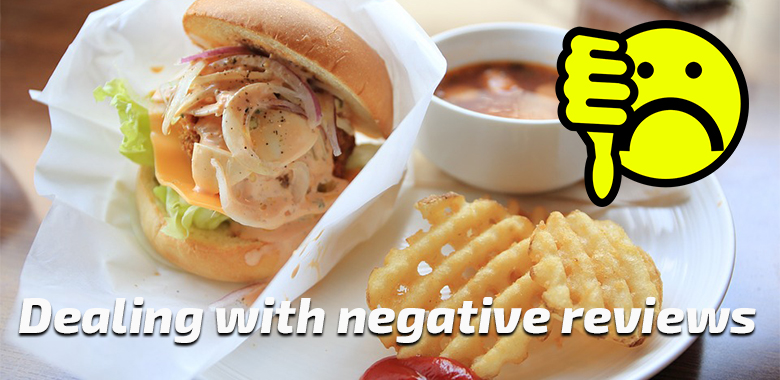
You can’t please everyone. It’s a fact. Some people are likely to not enjoy what you have to offer, or even how you offer it.
But in the food service industry, or in any industry for that matter, criticism can actually be a good thing.
You will learn more from your mistakes than anything you do correctly. It’s how you deal with these mistakes that counts.Sites like TripAdvisor, Yelp and Google Places are a great way as a consumer or customer to see what others like yourself are saying about a restaurant or establishment.
They are also a great way to see how your competitors are doing compared to yourself.
Many potential customers WILL look at your rating on TripAdvisor before deciding to come to you.
This shows how important it is to ensure that people are: a) talking about your establishment and b) have nice things to say about you, your staff and your business.
But as previously mentioned, it is difficult to please everyone, all of the time.
So how do we deal with negative reviews or feedback?
1. Negative reviews need attention
You can’t ignore a negative review left on your site, page or profile. When navigating an establishment review a 1 star is much more visible than a 5 star review.
So make sure you are paying attention to what people are saying, don’t dwell on them, but don’t ignore them either.
2. Take action
Make sure you are prompt with a response, a customer is likely to be more vocal in the first few days and hours after a review is posted, if you can set-up notifications for negative reviews. Do it.
Be apologetic, try and clarify what went wrong for the customer to leave a poor rating, offer incentives to win back their favour (if possible).
A quick public response with contact details to solve the issue will show that you care about what your customers have to say about you and your business.
3. Reach out to the person offline
Sometimes when a customer becomes irate, they may want to ‘out’ a business for a poor experience. In this case it might be easier to not air one’s dirty laundry in public, and try to resolve the issue via email or over the phone.
Leave an update on the review to state what action was taken to fix the issue.
4. Realise that emotions rule over reason
A negative review can be scathing due to many factors not dependent on just you business. Customers tend to leave either glowing or scathing review, barely anything in-between.
Always thank a customer for leaving a review, no matter how unreasonable their comments seem. Leave your contact details, and ask if there is anything you can do to help solve the problem.
Where warranted offer a discount, coupon or free-service.
5. Ask for defamatory reviews to be taken down
You can’t remove reviews in most cases, but if you believe that a review is defamatory or is derogatory of your character or even vilifies you, then you can lodge complaints to the review service providers.
Note: This process may take a few days.
6. Realise the value of rankings
Review websites have different metrics for establishing rankings based on a number of attributes, from reviewer activity to the number of reviews on an establishment.
Understand that sometimes a positive review can even be worse than no review at all, sometimes a 4-star review can be worse than a no review due to it lowering an average score.
Try and see why you weren’t able to get a perfect score and then use that as a way to improve your processes.
Everything you do needs to be excellent if you are to reach the top of the rankings.
7. Negative reviews should be the catalyst for change
The customer is always right, and by using negative review to streamline and enhance customer experience, you are more likely to see a return on your time invested.
Very few negative reviews are posted to ‘ruin’ your business, most are posted to get your attention.
Therefore give them your attention! It may reveal areas which you would never otherwise consider.
8. Check your competitors
You will have competitors in your business space.
They are likely to see similar reviews to yourself online, check how they deal with them, see where they may have gone wrong and try to use their mistakes as a road-amp for your success.
Learning from the mistakes made by others is better than making them yourself.
9. Get people talking
Encourage people to leave reviews about your establishment.
If people are talking about you and your business, you are much more likely to convert people to come and try what you have to offer.
Don’t try and bribe those leaving good reviews, this is not a good long-term option.
Tell people you are on TripAdvisor, Google Places, Yelp and more. Place a sticker in your window or leave a badge/link on your website.
This might seem silly, even if you do have some negative comments, but it builds trust.
10. Don’t just keep reviews to yourself
Inform employees of the comments left online, especially if they are mentioned.
This will help prevent future similar issues, and if positive, gives them a self-esteem boost, which could increase productivity.
Build a customer-focused business and reap the rewards.
The most important aspect of dealing with negative reviews, is not to dwell on them. You cannot expect to please everyone.
Customers can be notoriously difficult to deal with, but with the right attitude you should be able to convert or win these people back around.
See the good in bad reviews, and act upon them to improve not only your business, but your processes and customer service.
So don’t make an ordeal of dealing with bad reviews.
